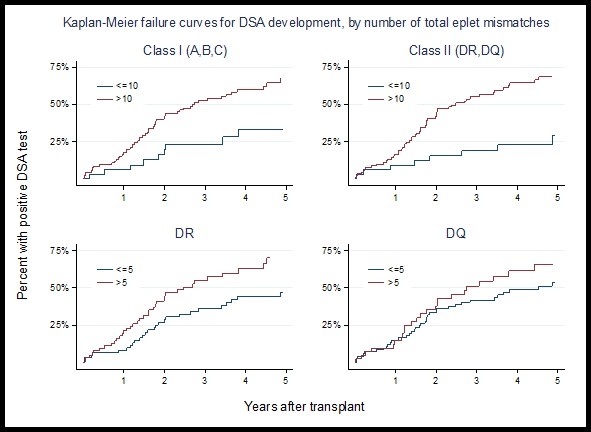Eplet Mismatches and De Novo Donor Surface Antibody Development in Pediatric Renal Transplant Recipients
1Seattle Children's Hospital, Seattle
2Bloodworks Northwest, Seattle
3UW Medicine, Seattle.
Meeting: 2018 American Transplant Congress
Abstract number: 54
Keywords: Epitopes
Session Information
Session Name: Concurrent Session: Kidney: Pediatrics - 1
Session Type: Concurrent Session
Date: Sunday, June 3, 2018
Session Time: 2:30pm-4:00pm
 Presentation Time: 2:30pm-2:42pm
Presentation Time: 2:30pm-2:42pm
Location: Room 3AB
Background: De novo donor surface antibody (dnDSA) development is arguably the first step in the natural history of allograft injury secondary to humoral alloimmunity. This project aims to investigate the association between eplet mismatches (MM) and the development of dnDSA in a pediatric population.
Methods: Retrospective cohort analysis of pediatric renal transplant recipients from 2008 to 2014 who underwent surveillance dnDSA testing with at least three years of follow up. We used the National Marrow Donor Program's Haplostats platform to impute high resolution HLA alleles (A, B, C, DR, and DQβ) from recipient and donor low resolution HLA alleles selecting the most commonly matched high resolution typing. We then generated eplet mismatches using HLA matchmaker version 2.0. We used multivariable Cox modeling to estimate associations between dichotomized MM counts (Class I & Class II total MM >10 vs. ≤10, DR & DQβ >5 vs. ≤5) and dnDSA development. Covariates included age at transplant, gender and donor type.
Results: A total of 126 subjects (median age 13 years, 64% male) met inclusion criteria. Of the 126 subjects, 50% developed any dnDSA (surveillance or for cause) during follow-up with a median time from transplant of 19.3 months. In models including both dichotomized Class I and Class II variables, Class II MM count >10 was independently associated with increased risk of dnDSA development (HR 3.39, 95% CI: 1.58-7.27, p<0.01) while the association with Class I MM count >10 failed to reach statistical significance (HR 1.70, 95% CI: 0.83-3.48, p=0.14). DR >5 MM alone was associated with increased risk of dnDSA development (HR 1.70, 95% CI: 1.00-2.88, p=0.048) while DQβ >5 alone was not (HR 1.45, 95% CI: 0.85-2.47, p=0.17).
Conclusions: Class II eplet mismatches are a strong independent predictor of dnDSA development in pediatric renal transplant recipients.
CITATION INFORMATION: Blanchette E., Bradford M., Warner P., Blosser C., Gimferrer I., Smith J. Eplet Mismatches and De Novo Donor Surface Antibody Development in Pediatric Renal Transplant Recipients Am J Transplant. 2017;17 (suppl 3).
To cite this abstract in AMA style:
Blanchette E, Bradford M, Warner P, Blosser C, Gimferrer I, Smith J. Eplet Mismatches and De Novo Donor Surface Antibody Development in Pediatric Renal Transplant Recipients [abstract]. https://atcmeetingabstracts.com/abstract/eplet-mismatches-and-de-novo-donor-surface-antibody-development-in-pediatric-renal-transplant-recipients/. Accessed December 16, 2025.« Back to 2018 American Transplant Congress
